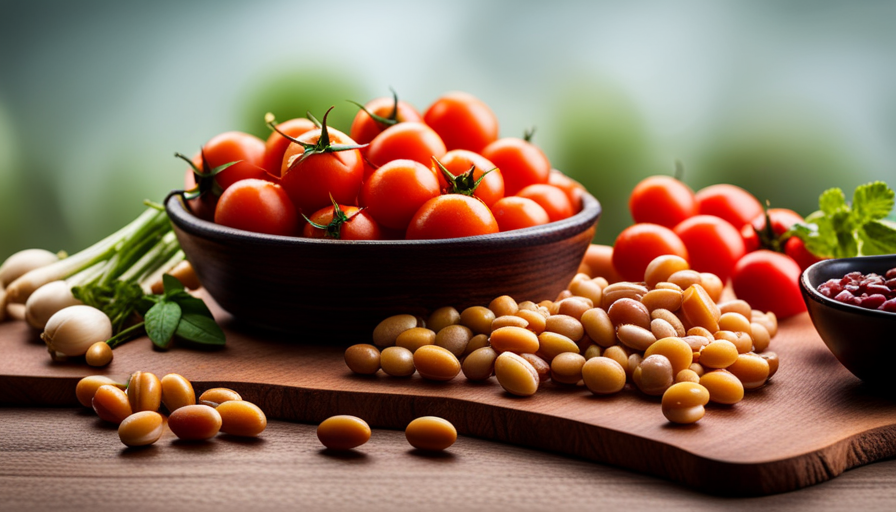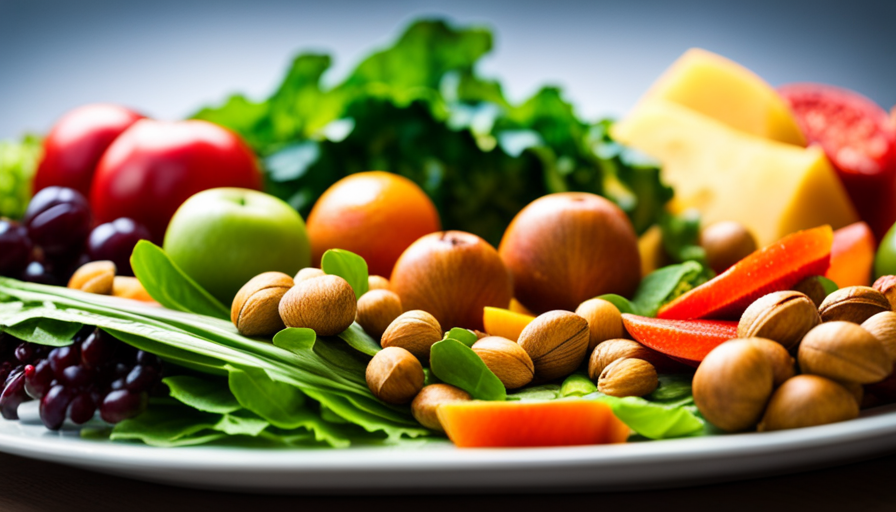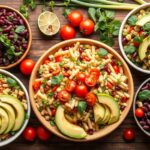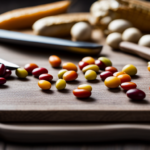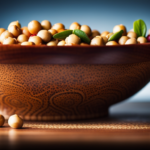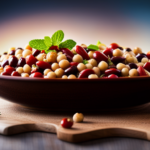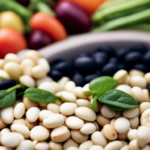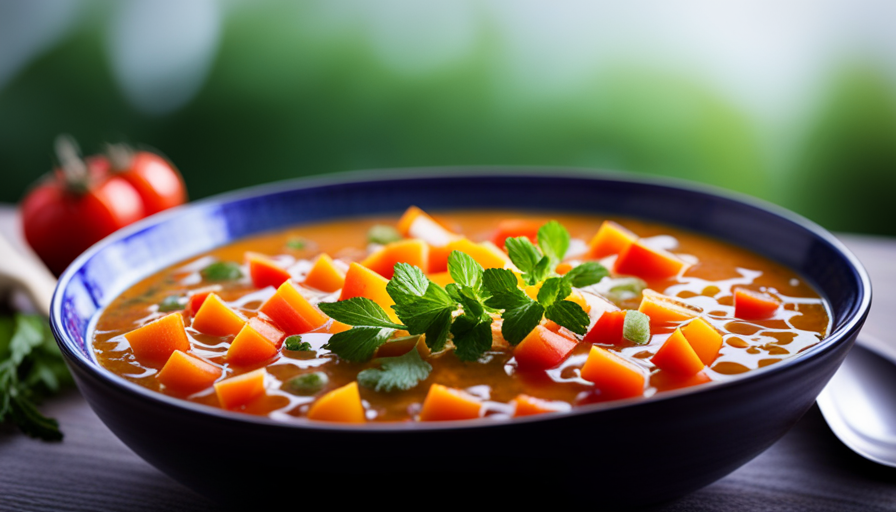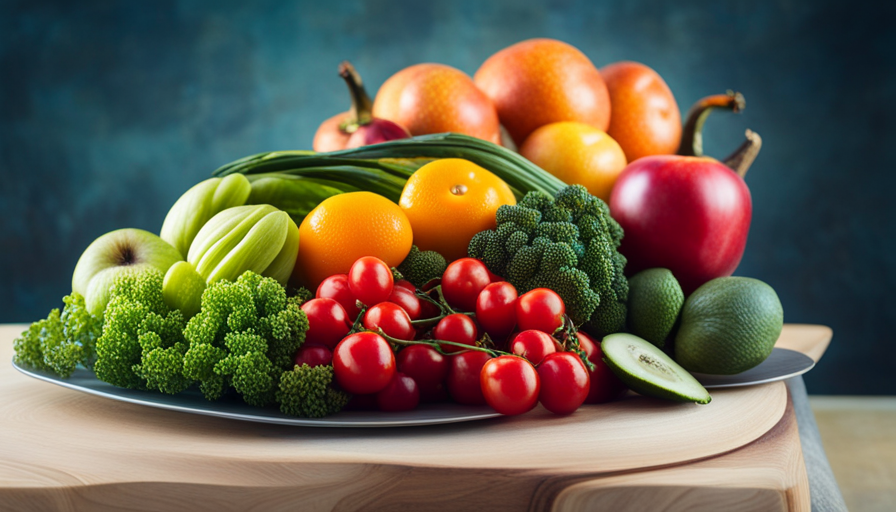Are you prepared to harness the potential of beans in your raw food regimen? These small legumes are full of essential nutrients like protein, fiber, vitamins, and minerals. Adding beans to your raw food plan not only diversifies your meals but also offers vital nutrients to promote your overall health and wellness.
In this article, we will show you how to unlock the full potential of beans in their raw form. From soaking and sprouting to blending and seasoning, we will guide you through a variety of creative ways to enjoy beans in your raw food meals. Whether you’re craving a creamy dip, a hearty salad, or a satisfying burger alternative, we’ve got you covered.
Get ready to take your raw food diet to the next level with the versatility and nourishment of beans. Let’s dive in and discover the endless possibilities that await!
Key Takeaways
- Soaking and sprouting beans can enhance their nutritional value and digestion on a raw food diet.
- Blending beans into smoothies and using them in raw desserts adds nutrients, protein, and flavor.
- Incorporating beans into raw wraps, tacos, and burgers provides a protein-packed base and adds texture and flavor.
- Fermenting beans promotes gut health and improves digestion on a raw food diet.
Soaking and Sprouting Beans
Soaking and sprouting beans is a crucial step in a raw food diet, as it not only enhances their nutritional value but also allows for easier digestion and absorption of nutrients. Sprouting techniques involve soaking the beans in water for a specific period, usually overnight, and then draining and rinsing them several times a day until they sprout tiny tails. This process activates enzymes that break down complex carbohydrates, making the beans easier to digest.
One of the main benefits of soaking beans is that it reduces their phytic acid content. Soaking beans before consuming them helps to neutralize phytic acid, making these minerals more bioavailable. Phytic acid is a natural compound found in beans that can interfere with the absorption of essential minerals like iron, calcium, and zinc.
Additionally, soaking and sprouting can increase the nutritional value of beans. Sprouted beans have higher levels of vitamins, minerals, and antioxidants compared to their non-sprouted counterparts. The sprouting process also breaks down anti-nutrients, such as enzyme inhibitors and lectins, which can hinder nutrient absorption and contribute to digestive issues.
By incorporating soaking and sprouting techniques into your raw food diet, you can maximize the nutritional benefits of beans while making them easier on your digestive system. So go ahead and give it a try – your body will thank you for it!
Blending Beans into Smoothies
To introduce a burst of flavor and a creamy texture to your smoothies, try blending beans into your favorite fruit combinations. Not only will this add a unique twist to your smoothies, but it’ll also provide you with a boost of nutrients and protein.
Here’s why you should start blending beans for smoothies:
-
Nutritional Powerhouse: Beans are loaded with essential nutrients like fiber, iron, and potassium. By blending them into your smoothies, you can easily incorporate these nutrients into your diet and support your overall health.
-
Creamy Texture: Blending beans creates a smooth and creamy texture, similar to that of a milkshake. This adds a pleasant mouthfeel to your smoothies and makes them more enjoyable to drink.
-
Enhanced Energy: Beans are a great source of slow-burning carbohydrates, which provide a steady release of energy throughout the day. By including them in your smoothies, you can create a nutritious and satisfying snack that’ll keep you energized.
But don’t limit yourself to just smoothies! You can also use blended beans to create bean-based energy bars. Simply blend cooked beans with dates, nuts, and your favorite flavors like cocoa powder or vanilla extract. Form the mixture into bars and refrigerate for a quick and healthy snack on the go.
So go ahead, grab your blender and start experimenting with blending beans into your smoothies and creating delicious bean-based energy bars.
Making Raw Bean Dips and Spreads
Get ready to elevate your snacking game by creating flavorful and creamy bean dips and spreads that’ll have you reaching for your favorite veggies and crackers in no time.
On a raw food diet, you can still enjoy the deliciousness of beans by making raw bean dips and spreads. Two popular options are raw bean hummus and raw bean pate.
Raw bean hummus is a fantastic alternative to traditional hummus. It’s made by blending soaked and sprouted beans with garlic, lemon juice, tahini, and olive oil. The result is a smooth and creamy dip that pairs perfectly with carrot sticks, cucumber slices, or your favorite gluten-free crackers.
If you’re looking for something a bit more unique, try making a raw bean pate. This spread is created by blending soaked and sprouted beans with herbs, spices, and a touch of olive oil. The flavors can vary depending on your preferences, but some popular options include sun-dried tomato and basil, or roasted red pepper and garlic. Spread it on a slice of raw veggie bread or use it as a dip for raw crackers.
Whether you choose to make raw bean hummus or raw bean pate, you’ll be amazed at how flavorful and satisfying they are. They’re packed with protein, fiber, and essential nutrients, making them a nutritious addition to your raw food diet. So go ahead, get creative, and enjoy these delicious raw bean dips and spreads.
Creating Raw Bean Salads
Ready to take your culinary skills to the next level? Let’s explore the vibrant world of raw bean salads and discover a whole new realm of flavor and texture.
Raw bean salads are a fantastic way to incorporate beans into your raw food diet while enjoying a variety of delicious flavors. Here are some tips to create the perfect raw bean salad:
-
Raw bean salad dressings: Experiment with different dressings to enhance the taste of your salad. Try a tangy lemon vinaigrette, a creamy avocado dressing, or a zesty lime and cilantro dressing. These dressings will add a burst of flavor to your salad and make it even more enjoyable.
-
Creative bean combinations in raw salads: Don’t be afraid to mix and match different types of beans to create unique and interesting flavor combinations. Combine black beans with corn and bell peppers for a Mexican-inspired salad, or mix chickpeas with cucumbers and tomatoes for a refreshing Mediterranean twist. The possibilities are endless, so let your creativity shine!
-
Add some crunch: To add texture and crunch to your salad, incorporate chopped vegetables like carrots, radishes, or celery. You can also throw in some toasted nuts or seeds for an extra bite. These crunchy additions will make your raw bean salad even more satisfying.
By following these tips, you’ll be able to create delicious and nutritious raw bean salads that’ll keep you satisfied and energized throughout the day. So go ahead, get creative, and enjoy the wonderful world of raw bean salads!
Raw Bean Soups and Stews
Now let’s delve into the delightful world of raw bean soups and stews, where flavors mingle and textures blend in perfect harmony. Raw bean soups and stews are not only delicious but also incredibly nutritious. They provide a wide range of health benefits that can enhance your raw food diet.
One of the benefits of raw bean soups is that they are packed with essential nutrients. Beans are a great source of protein, fiber, and vitamins, making them a perfect addition to your raw food diet. They can help to keep you feeling full and satisfied, while also providing a steady source of energy throughout the day.
Another advantage of raw bean soups and stews is their versatility. You can create a variety of flavors and textures by combining different types of beans with various vegetables and seasonings. From creamy white bean soups to hearty black bean stews, the possibilities are endless.
To give you a visual representation of the different types of raw bean soups and stews you can create, here is a table showcasing some delicious options:
| Soup/Stew | Beans Used | Vegetables | Seasonings |
|---|---|---|---|
| Creamy White Bean Soup | Cannellini Beans | Cauliflower, Garlic | Fresh Thyme, Sea Salt |
| Spicy Black Bean Stew | Black Beans | Bell Pepper, Onion | Cumin, Chili Powder |
| Mexican Three Bean Soup | Kidney Beans, Pinto Beans, Black Beans | Tomato, Corn, Onion | Cilantro, Lime, Cumin |
Incorporating raw bean soups and stews into your raw food diet not only adds variety to your meals but also provides numerous health benefits. So go ahead and explore the world of raw bean soups – your taste buds and body will thank you.
Fermenting Beans for Added Flavor
Immerse yourself in the enticing world of fermented beans, where flavors are intensified and taste buds come alive with each savory bite. Fermenting beans not only adds depth and complexity to your dishes, but it also offers numerous health benefits.
One of the main advantages of fermenting beans is that it promotes gut health. During the fermentation process, the natural sugars in the beans are broken down by beneficial bacteria, creating lactic acid. This lactic acid promotes the growth of good bacteria in your gut, improving digestion and boosting your overall immune system.
To create probiotic-rich dishes, follow these simple steps for fermenting beans:
-
Soak the beans: Start by soaking the beans overnight in water. This helps to soften them and remove any impurities.
-
Rinse and drain: After soaking, rinse the beans thoroughly and drain off the excess water.
-
Add flavorings: You can infuse your beans with various spices, herbs, and vegetables to enhance the taste. Popular choices include garlic, onion, ginger, and chili peppers.
-
Ferment: Place the beans in a clean jar or fermentation crock, ensuring they are fully submerged in a brine solution. Allow them to ferment at room temperature for a few days to a week, depending on your desired level of fermentation.
By incorporating fermented beans into your raw food diet, you can enjoy not only the rich flavors but also the numerous health benefits they offer. So why not give it a try and embark on a journey to a healthier gut and a more vibrant palate?
Dehydrating and Seasoning Beans for Snacks
Transforming beans into delectable snacks is as easy as dehydrating and seasoning them to create irresistible treats. When it comes to dehydrating techniques, there are a few options to choose from. You can use a food dehydrator, an oven, or even the sun. Regardless of the method, the key is to ensure that the beans are thoroughly dried to preserve their crunchiness and flavor.
To add a burst of flavor to your dehydrated beans, get creative with different seasonings. Here are some ideas to get you started:
-
Smoky BBQ: Combine smoked paprika, garlic powder, onion powder, and a touch of cayenne pepper for a spicy kick.
-
Zesty Ranch: Mix together dried dill, garlic powder, onion powder, dried parsley, and a sprinkle of lemon zest for a tangy and herby taste.
-
Spicy Chili Lime: Toss the beans with chili powder, lime zest, cumin, and a pinch of salt for a zingy and savory snack.
-
Sweet Cinnamon Sugar: For a sweet treat, sprinkle the beans with a mixture of cinnamon and coconut sugar before dehydrating.
By experimenting with different dehydrating techniques and creative bean seasonings, you can enjoy a variety of flavorful snacks that are both nutritious and delicious. So go ahead, give it a try and discover the endless possibilities of enjoying beans on your raw food diet.
Using Beans in Raw Desserts
Get ready to indulge in delicious desserts that incorporate the versatile and nutritious beans! Beans aren’t just for savory dishes anymore. They can be used in a variety of raw desserts that are both healthy and satisfying.
One great way to use beans in raw desserts is by incorporating them into raw energy bars. These bars are packed with protein, fiber, and other essential nutrients, making them a perfect on-the-go snack or post-workout treat.
To make raw energy bars with beans, start by blending cooked beans with dates, nuts, and your favorite sweetener like maple syrup or honey. Add in some raw cacao powder or vanilla extract for extra flavor. Once everything is blended together, press the mixture into a baking dish and refrigerate until firm. Cut into bars and enjoy!
Another delicious way to use beans in raw desserts is by incorporating them into raw ice cream. Simply blend cooked beans with frozen bananas, your choice of nut milk, and a sweetener like agave syrup or coconut sugar. You can also add in some vanilla extract or other flavorings to enhance the taste. Blend everything together until smooth and creamy, then freeze until firm. Serve in a bowl or cone and savor the creamy goodness guilt-free!
Incorporating beans into raw desserts not only adds a nutritional boost but also creates a unique and satisfying treat. So go ahead and experiment with beans in your next raw dessert creation, and enjoy the benefits of this versatile ingredient.
Incorporating Beans into Raw Wraps and Tacos
Now that you’ve learned how to use beans in raw desserts, let’s explore another exciting way to incorporate these nutritious powerhouses into your raw food diet: raw wraps and tacos!
Beans can provide a satisfying and protein-packed base for your wraps, adding a delicious and nutritious twist to this classic dish.
One creative way to use beans in raw wraps is by making a raw bean-based pizza crust. Simply blend together sprouted beans, flaxseeds, and your favorite herbs and spices to create a flavorful and nutritious crust. Spread your favorite raw tomato sauce, add a variety of fresh vegetables, and voila! You have a delicious and healthy raw bean-based pizza wrap that will leave you feeling satisfied and energized.
Another fantastic idea is incorporating beans into raw sushi rolls. Instead of traditional rice, use a combination of blended beans and vegetables to create a creamy and flavorful filling. Wrap it in a sheet of nori, add some fresh veggies, and you have a nutritious and protein-packed raw sushi roll.
By incorporating beans into your raw wraps and tacos, you not only add a variety of textures and flavors but also boost the nutritional value of your meal. So why not give it a try and experience the delicious possibilities of incorporating beans into your raw food diet?
Exploring Raw Bean-Based Burger Alternatives
Introducing an innovative twist to your culinary repertoire, let’s delve into the realm of raw bean-based burger alternatives that will ignite your taste buds and leave you craving for more. When it comes to raw bean consumption, the possibilities are endless. Not only do bean-based burgers provide a delicious and satisfying meal option, they also offer numerous health benefits.
Bean based burger recipes allow you to enjoy the goodness of beans in a convenient and tasty way. By combining different types of beans, such as black beans, chickpeas, and lentils, with flavorful herbs and spices, you can create a mouthwatering patty that rivals any traditional burger. These plant-based alternatives are packed with protein, fiber, and essential nutrients, making them a nutritious choice for those following a raw food diet.
The benefits of raw bean consumption are abundant. Beans are an excellent source of plant-based protein, which helps build and repair tissues in the body. They are also rich in dietary fiber, promoting a healthy digestive system and aiding in weight management. Moreover, beans contain a variety of vitamins and minerals, including iron, potassium, and folate, which are essential for overall well-being.
To give you an idea of the versatility of raw bean-based burgers, here is a table showcasing three different recipes:
| Bean Type | Flavor Profile | Additional Ingredients |
|---|---|---|
| Black Beans | Bold and smoky | Cumin, paprika, and corn |
| Chickpeas | Mediterranean-inspired | Garlic, lemon, and parsley |
| Lentils | Earthy and savory | Onion, garlic, and thyme |
With these enticing options, you can create a variety of flavors to suit your taste preferences. So why not give raw bean-based burgers a try? Not only will you be indulging in a delicious meal, but you’ll also be reaping the numerous benefits that beans have to offer.
Frequently Asked Questions
Can I eat beans raw without soaking or sprouting them first?
Eating raw beans without soaking or sprouting them first isn’t recommended. Soaking and sprouting beans in a raw food diet is essential for maximizing their nutritional value and health benefits. Soaking helps remove anti-nutrients, increase digestibility, and enhance nutrient absorption. Sprouting further boosts the nutrient content, making the beans more easily digestible and reducing the risk of digestive discomfort.
Incorporating soaked or sprouted beans into your raw food diet ensures you get the most out of this nutritious food.
How long should I soak beans before using them in a raw food diet?
To ensure optimal digestion and nutrient absorption, it’s recommended to soak raw beans before using them in a raw food diet. Soaking time for raw beans varies depending on the type, but generally, 8-12 hours is sufficient.
Soaking not only softens the beans, making them easier to eat, but it also helps remove anti-nutrients, making the beans more digestible. Additionally, sprouting beans further enhances their nutritional value by increasing their enzyme content and reducing phytic acid levels.
Can I blend any type of beans into smoothies, or are some better than others?
Blend any type of beans into smoothies for a delicious and nutritious addition to your raw food diet. While some beans may have a more distinct flavor, like black beans or chickpeas, all beans offer incredible benefits. They’re packed with protein, fiber, and essential vitamins and minerals. Blending beans into smoothies provides a creamy texture and adds a nutritional boost.
So go ahead and experiment with different types of beans to find your favorite smoothie combination! As the saying goes, "Variety is the spice of life."
Are there any specific seasonings or ingredients I should use when making raw bean dips and spreads?
To make delicious raw bean dips and spreads, start by sprouting your beans at home using different methods like soaking and rinsing. This process unlocks the beans’ nutrients and makes them easier to digest.
When it comes to seasonings and ingredients, get creative! You can add garlic, lemon juice, cumin, or fresh herbs to enhance the flavor.
Store your raw bean dips and spreads in airtight containers in the fridge to maintain their freshness and extend their shelf life.
Can I use canned beans in raw bean salads, or do I need to use fresh or soaked beans?
You can use canned beans in raw bean salads, but it’s recommended to use fresh or soaked beans for a raw food diet. While canned beans are convenient, they often contain added sodium and preservatives. Fresh beans, on the other hand, retain more nutrients and have a better texture. Soaking beans before consuming them raw can also make them easier to digest and increase nutrient availability. For the best results, opt for fresh or soaked beans in your raw food recipes.
Can Beans Be Included in a Raw Food Diet?
Yes, including eating raw beans on raw diet is not recommended. Raw beans contain lectins, which can be toxic and cause gastrointestinal issues. It is best to cook beans before consuming them to make them safe and digestible in a raw food diet.
Conclusion
In conclusion, incorporating raw beans into your diet can be a delicious and nutritious addition to your raw food lifestyle. By soaking and sprouting beans, blending them into smoothies, making dips and spreads, creating salads, soups, and stews, dehydrating them for snacks, using them in desserts, and even in wraps and tacos, you can explore a whole new world of flavors and textures.
So why not give it a try? Get creative and enjoy the benefits of raw beans today! Your taste buds and your body will thank you.

